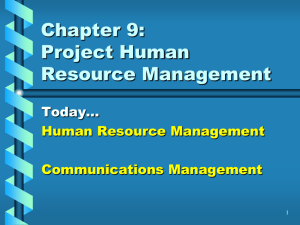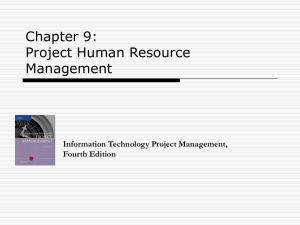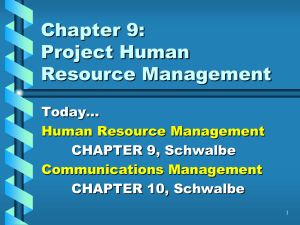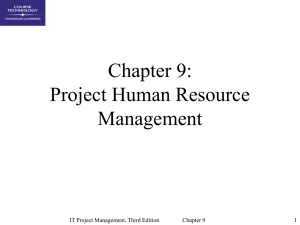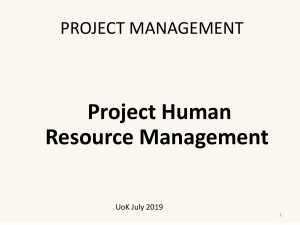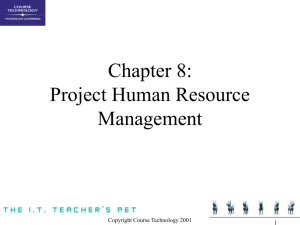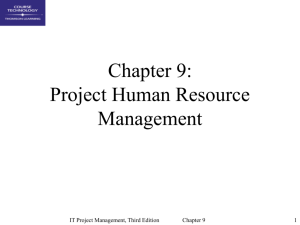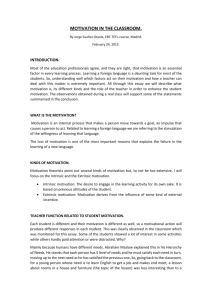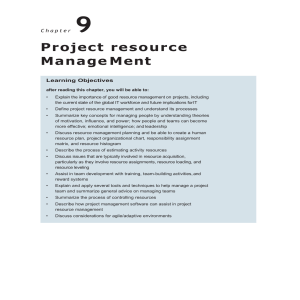Extra on Project HR Management (chapter 9)
advertisement
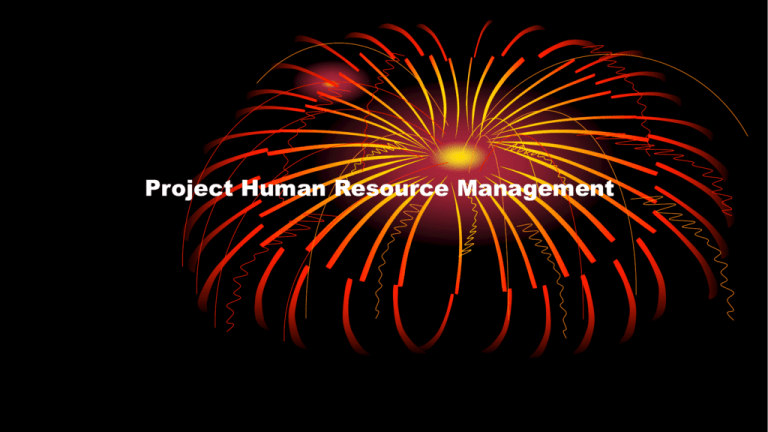
Project Human Resource Management Learning Objectives • Explain the importance of good human resource management on projects, including the current state and future implications of human resource management, especially on information technology projects. • Define project human resource management and understand its processes. • Summarize key concepts for managing people by understanding the theories of Abraham Maslow, Frederick Herzberg, David McClelland, and Douglas McGregor on motivation, H. J. Thamhain and D. L. Wilemon on influencing workers, and Stephen Covey on how people and teams can become more effective. Learning Objectives • Discuss human resource planning and be able to create a project organizational chart, responsibility assignment matrix, and resource histogram. • Understand important issues involved in project staff acquisition and explain the concepts of resource assignments, resource loading, and resource leveling. • Assist in team development with training, team-building activities, and reward systems. • Explain and apply several tools and techniques to help manage a project team and summarize general advice on managing teams. • Describe how project management software can assist in project human resource management. The Importance of Human Resource Management • Many corporate executives have said, “People are our most important asset” • People determine the success and failure of organizations and projects What is Project Human Resource Management? • Making the most effective use of the people involved with a project. • Processes include: • Human resource planning: Identifying and documenting project roles, responsibilities, and reporting relationships. • Acquiring the project team: Getting the needed personnel assigned to and working on the project. • Developing the project team: Building individual and group skills to enhance project performance. • Managing the project team: Tracking team member performance, motivating team members, providing timely feedback, resolving issues and conflicts, and coordinating changes to help enhance project performance. Keys to Managing People • Psychologists and management theorists have devoted much research and thought to the field of managing people at work. • Important areas related to project management include: • Motivation theories • Influence and power • Effectiveness Intrinsic and Extrinsic Motivation • Intrinsic motivation causes people to participate in an activity for their own enjoyment. • Extrinsic motivation causes people to do something for a reward or to avoid a penalty. • For example, some children take piano lessons for intrinsic motivation (they enjoy it) while others take them for extrinsic motivation (to get a reward or avoid punishment). Maslow’s Hierarchy of Needs • Abraham Maslow argued that human beings possess unique qualities that enable them to make independent choices, thus giving them control of their destiny. • Maslow developed a hierarchy of needs, which states that people’s behaviors are guided or motivated by a sequence of needs. Maslow’s Hierarchy of Needs Herzberg’s Motivational and Hygiene Factors • Frederick Herzberg wrote several famous books and articles about worker motivation. He distinguished between: • Motivational factors: Achievement, recognition, the work itself, responsibility, advancement, and growth. These factors produce job satisfaction. • Hygiene factors: Larger salaries, more supervision, and a more attractive work environment. These factors cause dissatisfaction if not present, but do not motivate workers to do more. McClelland’s Acquired-Needs Theory • Specific needs are acquired or learned over time and are shaped by life experiences. The following are the main categories of acquired needs: • Achievement (nAch): People with a high need for achievement like challenging projects with attainable goals and lots of feedback. • Affiliation (nAff): People with high need for affiliation desire harmonious relationships and need to feel accepted by others, so managers should try to create a cooperative work environment for them. • Power (nPow): People with a need for power desire either personal power (not good) or institutional power (good for the organization). Provide institutional power seekers with management opportunities. McGregor’s Theory X and Y • Douglas McGregor popularized the human relations approach to management in the 1960s. • Theory X: Assumes workers dislike and avoid work, so managers must use coercion, threats, and various control schemes to get workers to meet objectives. • Theory Y: Assumes individuals consider work as natural as play or rest and enjoy the satisfaction of esteem and self-actualization needs. • Theory Z: Introduced in 1981 by William Ouchi and is based on the Japanese approach to motivating workers, which emphasizes trust, quality, collective decision making, and cultural values. Thamhain and Wilemon’s Ways to Have Influence on Projects 1. Authority: The legitimate hierarchical right to issue orders. 2. Assignment: The project manager's perceived ability to influence a worker's later work assignments. 3. Budget: The project manager's perceived ability to authorize others' use of discretionary funds. 4. Promotion: The ability to improve a worker's position. 5. Money: The ability to increase a worker's pay and benefits. Thamhain and Wilemon’s Ways to Have Influence on Projects (cont’d) 6. Penalty: The project manager's ability to cause punishment. 7. Work challenge: The ability to assign work that capitalizes on a worker's enjoyment of doing a particular task. 8. Expertise: The project manager's perceived special knowledge that others deem important. 9. Friendship: The ability to establish friendly personal relationships between the project manager and others. Ways to Influence that Help and Hurt Projects • Projects are more likely to succeed when project managers influence people using: • Expertise • Work challenge • Projects are more likely to fail when project managers rely too heavily on: • Authority • Money • Penalty Power • Power is the potential ability to influence behavior to get people to do things they would not otherwise do. • Types of power include: • Coercive power • Legitimate power • Expert power • Reward power • Referent power Improving Effectiveness: Covey’s Seven Habits • Project managers can apply Covey’s seven habits to improve effectiveness on projects. • Be proactive. • Begin with the end in mind. • Put first things first. • Think win/win. • Seek first to understand, then to be understood. • Synergize. • Sharpen the saw. Empathic Listening and Rapport • Good project managers are empathic listeners, meaning they listen with the intent to understand. • Before you can communicate with others, you have to have rapport, which is a relation of harmony, conformity, accord, or affinity. • Mirroring is the matching of certain behaviors of the other person, and is a technique used to help establish rapport. • IT professionals need to develop empathic listening and other people skills to improve relationships with users and other stakeholders. Acquiring the Project Team • Acquiring qualified people for teams is crucial. • The project manager who is the smartest person on the team has done a poor job of recruiting! • Staffing plans and good hiring procedures are important, as are incentives for recruiting and retention. • Some companies give their employees one dollar for every hour that a new person who they helped hire works. • Some organizations allow people to work from home as an incentive. Myers-Briggs Type Indicator (MBTI) • MBTI is a popular tool for determining personality preferences and helping teammates understand each other. • Four dimensions include: • • • • Extrovert/Introvert (E/I) Sensation/Intuition (S/N) Thinking/Feeling (T/F) Judgment/Perception (J/P) • NTs, or rationals, are attracted to technology fields. • IT people vary most from the general population in their tendency to not be extroverted or sensing. Wideman and Shenhar’s Views on MBTI and Project Management* • Most suited for project leadership: • 100 percent: INTJ, ENTJ, ISTJ, ESTJ • 50 percent: INTP, ENTP, ENFP, ENFJ • Best suited as followers: • 100 percent: INFJ, ISFJ • 50 percent: INTP, ENTP, ENFP, ENFJ, ESFJ • Not suited for project work: • 100 percent: INFP, ISFP, ESFP, ISTP • 50 percent: ENFP, ESTP *Wideman, R. Max and Aaron J. Shenhar, “Professional and Personal Development: A Practical Approach to Education and Training,” Project Management for Business Professionals, edited by Joan Knutson, 2001, p. 375. MBTI and Suitability to Project Work* What do you think about these views? *Wideman, R. Max. “Project Teamwork, Personality Profiles and the Population at Large: Do we have enough of the right kind of people?” (http://www.maxwideman.com/papers/profiles/profiles.pdf ). Social Styles Profile • People are perceived as behaving primarily in one of four zones, based on their assertiveness and responsiveness: • • • • Drivers Expressives Analyticals Amiables • People on opposite corners (drivers and amiables, analyticals and expressives) may have difficulty getting along. Social Styles Developing the Project Team • The main goal of team development is to help people work together more effectively to improve project performance. • It takes teamwork to successfully complete most projects. Tuckman Model of Team Development • Forming • Storming • Norming • Performing • Adjourning Training • Training can help people understand themselves and each other, and understand how to work better in teams. • Team building activities include: • Physical challenges • Psychological preference indicator tools Managing the Project Team • Project managers must lead their teams in performing various project activities. • After assessing team performance and related information, the project manager must decide: • If changes should be requested to the project. • If corrective or preventive actions should be recommended. • If updates are needed to the project management plan or organizational process assets. Tools and Techniques for Managing Project Teams • Observation and conversation • Project performance appraisals • Conflict management • Issue logs Reward and Recognition Systems • Team-based reward and recognition systems can promote teamwork. • Focus on rewarding teams for achieving specific goals. • Allow time for team members to mentor and help each other to meet project goals and develop human resources. Why People Leave Their Jobs • They feel they do not make a difference. • They do not get proper recognition. • They are not learning anything new or growing as a person. • They do not like their coworkers. • They want to earn more money. General Advice on Teams • Be patient and kind with your team. • Fix the problem instead of blaming people. • Establish regular, effective meetings. • Allow time for teams to go through the basic teambuilding stages. • Limit the size of work teams to three to seven members. General Advice on Teams (cont’d) • Plan some social activities to help project team members and other stakeholders get to know each other better. • Stress team identity. • Nurture team members and encourage them to help each other. • Take additional actions to work with virtual team members. Resource Loading • Resource loading refers to the amount of individual resources an existing schedule requires during specific time periods. • Helps project managers develop a general understanding of the demands a project will make on the organization’s resources and individual people’s schedules. • Overallocation means more resources than are available are assigned to perform work at a given time. Staffing Management Plans and Resource Histograms • A staffing management plan describes when and how people will be added to and taken off the project team. • A resource histogram is a column chart that shows the number of resources assigned to a project over time. Sample Resource Histogram Sample Histogram Showing an Overallocated Individual What’s wrong with this picture? Assume 100 percent means Joe is working eight hours per day. Resource Leveling • Resource leveling is a technique for resolving resource conflicts by delaying tasks. • The main purpose of resource leveling is to create a smoother distribution of resource use and reduce overallocation. Resource Leveling Example Benefits of Resource Leveling • When resources are used on a more constant basis, they require less management. • It may enable project managers to use a just-in-time inventory type of policy for using subcontractors or other expensive resources. • It results in fewer problems for project personnel and the accounting department. • It often improves morale. Using Software to Assist in Human Resource Management • Software can help produce RAMS and resource histograms. • By using project management software for human resource management, you can: • Assign resources. • Identify potential resource shortages or underutilization. • Level resources. Project Resource Management Involves Much More Than Using Software • Project managers must: • Treat people with consideration and respect. • Understand what motivates people. • Communicate carefully with people. • Focus on your goal of enabling project team members to deliver their best work.

